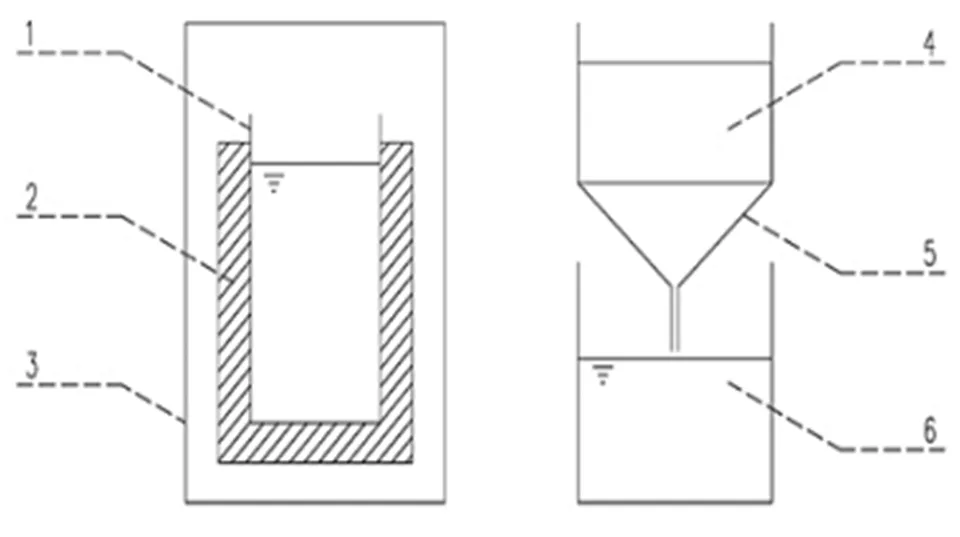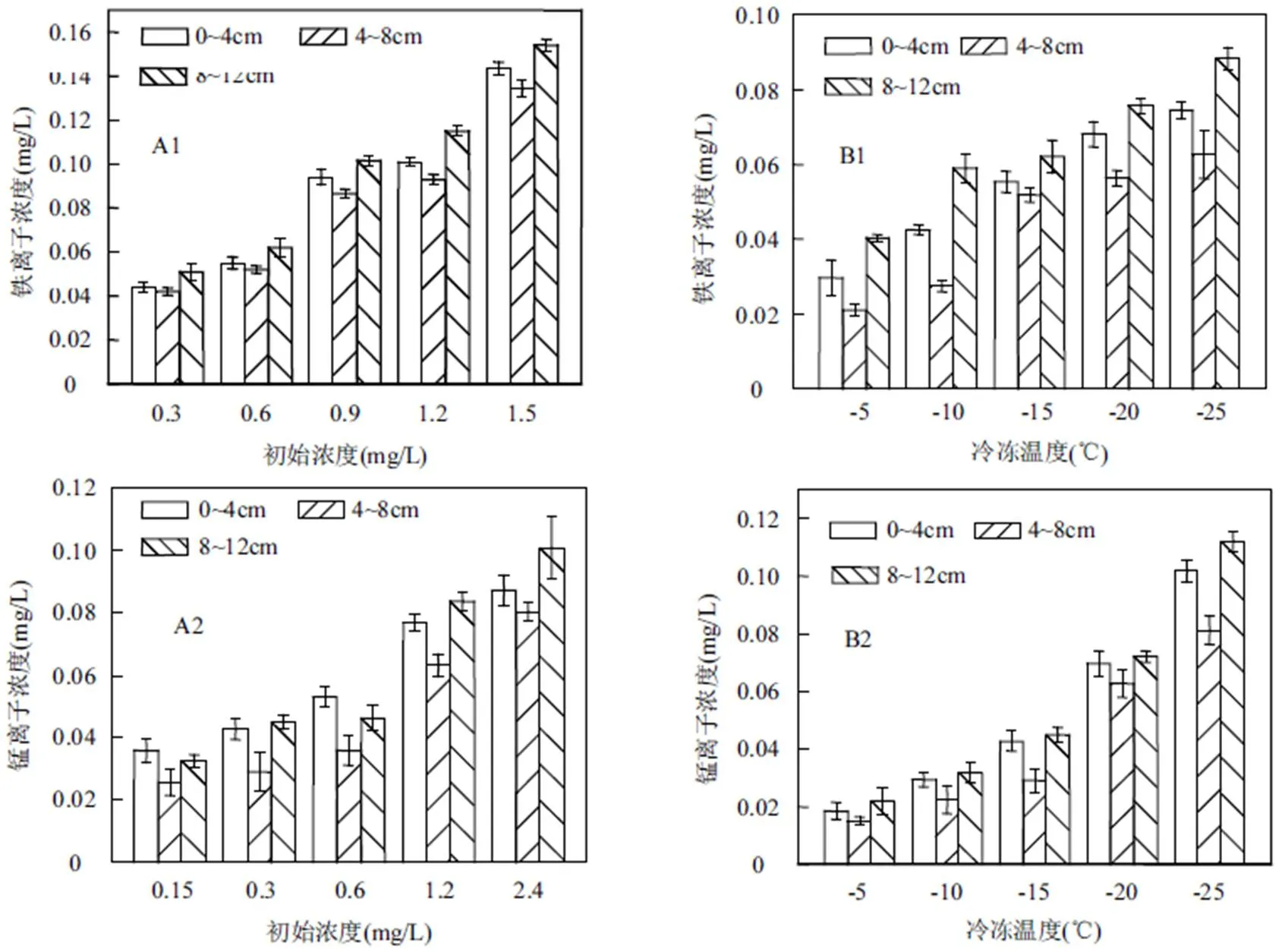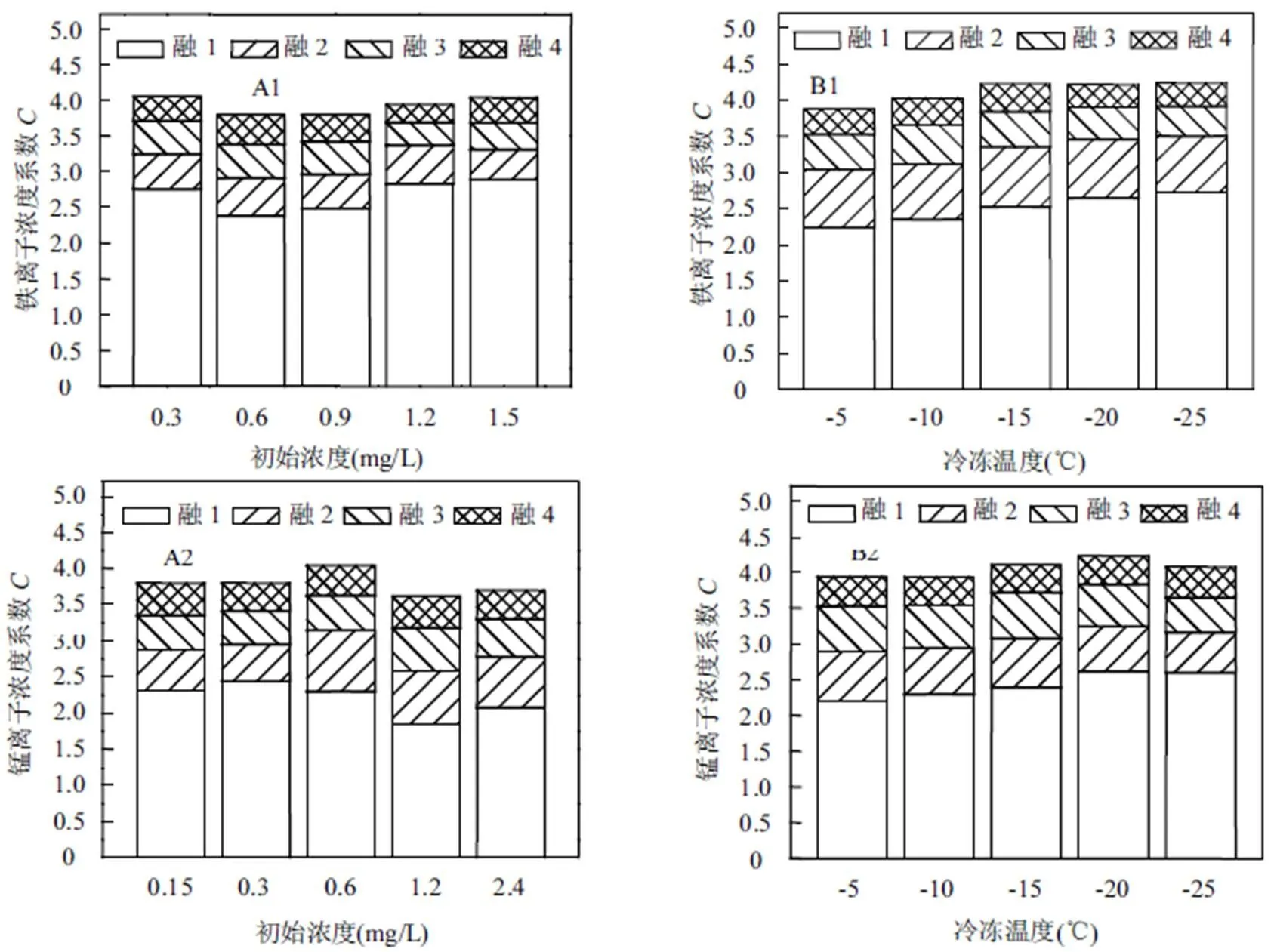融冰过程中铁离子和锰离子的迁移规律
张 岩,任方云,唐元庆,赵万里,赵同国,刘同帅,刘玉灿,SHEN Hung Tao
融冰过程中铁离子和锰离子的迁移规律
张 岩1*,任方云1,唐元庆1,赵万里1,赵同国1,刘同帅1,刘玉灿1,SHEN Hung Tao2
(1.烟台大学土木工程学院,山东 烟台 264005;2.克拉克森大学土木与环境工程系,美国 波茨坦 13699-5710)
为探究融冰过程中重金属离子的迁移规律,选择铁离子和锰离子为研究对象,开展了室内模拟融冰实验,探讨其在融冰过程中的迁移规律,并分析初始浓度和冷冻温度对其迁移过程的影响.结果表明:在不同的初始浓度和冷冻温度条件下,铁离子和锰离子在冰中各层的浓度分布关系皆为:中层<上层<下层;融冰过程中,51.17%~71.67%的铁离子和锰离子均在冰体融化前期(0~25%)集中释放,中后期相对平稳均匀释放,此外初始浓度对冰融化时铁离子和锰离子的迁移规律影响不大,而冷冻温度较低时,融1中铁离子和锰离子的浓度基本在增加;融冰过程中,随着累积融水体积的增加,融水中铁离子和锰离子的浓度与冰体初始浓度之比逐渐降低,它们之间呈指数函数衰减模式.
融冰;铁离子;锰离子;迁移规律
中国北方冬季漫长而寒冷,湖泊、水库和河流等每年有3~5个月的时间被冰雪覆盖[1-2].水体结冰过程中,水中的污染物会被截留在冰体中[3-4].翌年初春冰逐渐融化,导致冰中的污染物被释放出来,成为承纳水体的污染源,甚至会在水体沉积物中积累[5-6],对水环境产生威胁.随着全球气候逐渐变暖[7],寒冷地区水体的冰封期缩短,冰川融化加速,这使得研究融化过程中污染物的迁移规律迫在眉睫.
现已公开的有关淡水研究的文献中,只有2%涉及水体结冰过程[8],且主要集中在氮、磷、金属离子,有机污染物等物质研究[9-13].关于融冰过程研究的文献相对匮乏,近些年仅有的一些文献多集中于有机污染物释放[14-17]和融水对微生物的影响[18-20].如Xue等[21]评估了融化冰中溶解有机物(DOM)的洗脱行为,结果表明DOM融化过程中表现出早期洗脱现象;李志军等[22]研究发现融化过程中,冰内硝基苯“原位不动”,冰内的硝基苯不发生迁移,只随冰的融化迁移到水体中.Kanna等[23]将含有一定量铁的海水与海冰一起冷冻,以评估海冰融化释放出的铁中哪些有利于浮游植物的生长.而关于融冰过程中重金属离子释放的研究还鲜有报道.铁离子和锰离子作为最常见的2种过渡重金属,它们以各种溶解态离子的形式存在于水生环境中,过量的铁离子和锰离子不仅会引起视觉问题,也会通过食物链的放大影响生物体的健康[24].基于此,本研究以铁离子和锰离子为对象,开展了室内模拟融冰实验,探讨其在融冰过程中的迁移规律,并分析初始浓度和冷冻温度对其迁移过程的影响,以期明确融冰过程对水体环境的影响,引起人们对融冰过程环境效应的关注.
1 材料与方法
1.1 实验装置
为模拟自然水体自上而下的结冰过程,本研究采用一种自制的敞口单向导冷结冰模拟装置(图1).将水样装入圆柱形玻璃桶(10cm、29.5cm),玻璃桶四周及底部用聚苯乙烯泡沫(EPS)保温材料包裹以阻断桶体与外界进行热量传递,确保冰体自上而下逐渐生长,将上述装置置于带温度控制的低温实验箱中.将获得的冰样放入带有圆柱形玻璃壁的融冰装置中融化,收集冰融水.

图1 结冰装置(左)与融冰装置(右)
1-玻璃桶;2-EPS保温材料;3-低温实验箱;4-冰样;5-带玻璃圆筒的漏斗;6-融冰水样
1.2 药品与检测
主要药品:硫酸亚铁铵、电解锰、乙酸钠、邻菲啰啉等,以上药品均为分析纯,生产厂家为烟台北联.
检测方法:所有样品3个平行,样品中铁离子和锰离子总量的检测方法均按照《水和废水检测方法》(第四版)[25]进行检测,检测结果的标准差控制在5%以内.
1.3 实验设计
为了探究融冰过程中金属离子的迁移规律,选取铁离子和锰离子为研究对象,探究不同初始浓度(A组)和不同结冰温度(B组)对其释放规律的影响.
将A组分为A1组(铁离子)和A2组(锰离子).根据我国《生活饮用水卫生标准》(GB5749-2006)[26]对铁离子和锰离子的限制浓度,设定A1组的初始浓度为0.3, 0.6, 0.9, 1.2, 1.5mg/L,A2组的初始浓度为0.15, 0.3, 0.6, 1.2, 2.4mg/L,每种浓度的溶液各8L分别置于结冰模拟器中(占反应器体积的4/5),置于-15℃的低温箱中,当冰厚达到12cm时取出,将所得的整个冰体置于25℃恒温箱中连续融化,将冰融水根据融出的先后顺序平均分为4份,依次定义为融1,融2,融3,融4,检测融水样品中铁离子和锰离子的浓度.由于金属离子在冰体中的分布情况也会影响其在融冰过程中的迁移,为此,以上述同样的方式获得冰样,将所得冰样样本每4cm进行分层,定义0~4cm为上层,4~8cm为中层,8~12cm为下层,分别置于烧杯中在25℃恒温箱中条件下融化,然后检测铁离子和锰离子的浓度.
将B组分为B1组(铁离子)和B2组(锰离子).B1组的初始浓度为0.6mg/L,B2组的初始浓度为0.3mg/L,各配置40L,每种溶液各取8L分别置于结冰模拟器中(占反应体积的4/5),分别置于-5, -10, -15, -20和-25℃的低温箱中,当冰厚达到12cm时取出,将所得的整个冰体置于25℃恒温箱中连续融化,根据冰融水融出的先后顺序平均分为4份,依次定义为融1,融2,融3,融4,检测融水样品中铁离子和锰离子的浓度.由于金属离子在冰体中的分布情况也会影响其在融冰过程中的迁移,为此,以上述同样的方式获得冰样,将所得冰样样本每4cm进行分层,定义0~4cm为上层,4~8cm为中层,8~12cm为下层,分别置于烧杯中在25℃恒温箱中条件下融化,然后检测铁离子和锰离子的浓度.
1.4 分析方法
采用浓度系数()描述冰融化过程中铁离子和锰离子的浓度规律,该浓度系数定义为每等份融水中离子浓度与冰体中离子的总浓度之比,即

式中:C为每等份融水中离子浓度, mg/L,=1、2、3、4,依次为融1,融2,融3,融4,ice为冰相中离子的总浓度, mg/L.
采用融出率()从质量的角度描述冰融化过程中铁离子和锰离子的迁移能力,该融出率定义为每等份融水中离子的质量与冰体中离子的总质量之比,即:

式中:m为每等份融水中离子质量, mg,=1、2、3、4,依次为融1,融2,融3,融4,ice为冰相中离子的总质量, mg.
2 结果与讨论
2.1 铁离子和锰离子在冰体中的分布
当水体结冰时,冰生长速率较快,铁离子和锰离子会来不及迁移到冰下水体而被截留在冰体里[27-28].被截留的铁离子和锰离子在冰中的分布会决定它们在初融时期能否形成连通的排水通道,并且在初融时期,分布在冰体不同部位的铁离子和锰离子是随机选择某些排水通道融出[29].因此,冰晶内和冰晶上铁离子和锰离子的分布对融水成分至关重要[30],在探究融冰过程中铁离子和锰离子的迁移规律前,需要对冰体里铁离子和锰离子的分布情况进行研究.
如图2所示,铁离子和锰离子在冰中分布浓度关系为:中层<上层<下层,即铁离子和锰离子在冰中的分布随冰厚的增加呈现C型分布[31-32].这是由于结冰初期冰体生长速率较快,容易形成树枝状冰,这种结构冰易捕获铁离子和锰离子,因此冰上层铁离子和锰离子浓度较高[33].随着结冰的进行,冰厚的增加减弱了与外界的热量交换,冰生长速率较低,树枝状冰不易形成或者量较少,使得中层冰体里的铁离子和锰离子含量较少.由于冷冻浓缩的影响,越靠近冰水界面的冰体自然捕获的铁离子和锰离子要多,所以底层离子含量要大于上层和中层[34].此外,铁离子和锰离子在冰体中的浓度与初始浓度呈正相关,与冷冻温度呈负相关,即随着初始浓度的增大,冷冻温度的降低,铁离子和锰离子在冰体中的浓度也逐渐增加.这是因为冷冻温度越低,冰的生长速率越高,而初始浓度越高,也使得溶液中潜在晶核数量增多,晶核互相碰撞的频率和能量增加,二次成核概率增加,冰晶生长速度加快,导致冰纯度降低[35].

图2 不同初始浓度和不同冷冻温度下铁、锰离子在冰体中的分布
A:初始浓度;B:冷冻温度;1:铁离子;2:锰离子
2.2 铁离子和锰离子在融冰过程中的迁移规律
由图3~4可知,在冰的融化过程中,铁离子和锰离子的浓度随着融化比率的增加逐渐降低,即融1>融2>融3>融4.冰体中的铁离子和锰离子在初期(0~25%)会释放51.17%~71.67%,初期融水的浓度系数在1.85~2.89之间.
冰融化时铁离子和锰离子集中释放可以从3个角度解释:(1)从铁离子和锰离子在冰中的分布来看,结冰过程中,被捕获在冰体里的铁离子和锰离子是存在于晶体的表面或者冰晶界处,当表层冰开始融化时,初期会融出大量铁离子和锰离子,后期融出来的是来自被困在晶体内部的铁离子和锰离子,其含量较少[36-37],所以不同初始浓度和不同冷冻温度下所获得的冰体在融化过程中,铁离子和锰离子均呈现前期集中释放,中后期相对平稳均匀释放.(2)从冰融化机理来看,铁离子和锰离子被捕获在冰晶里时会以液袋的形式存在,随着温度的逐渐升高,冰体开始瓦解,液袋慢慢向下移动,冰内部之间会形成类似树干和树枝的流动线, 称为排水通道,铁离子和锰离子慢慢就沿着排水通道融出[38].为了示踪排水通道,在-15℃将1.6L的1mg/L的紫红色高锰酸钾溶液完全冻结,然后切片在普通光学显微镜下40倍观察,如图5所示,被截留在冰体里的高锰酸钾以液袋的形式存在,在初融之际,许多液袋会慢慢贯穿成一条一条排水通道.(3)从热力学的角度来看,为了维持温度和浓度之间的热力学平衡,排水通道的热量传递由与液相体积增加相关的潜热变化控制,所以,铁离子和锰离子通过排水通道的传质速率对传热速率只有二级影响,对“被困在排水通道周围冰体中的溶液”的洗涤速率也只有二级影响[39].接着在较小的流速下,分子扩散会导致杂质的扩散,从而导致高浓度的铁离子和锰离子和少量融化液排出[40].

图3 不同浓度和不同冷冻温度下铁、锰离子的浓度系数
A:初始浓度;B:冷冻温度;1:铁离子;2:锰离子
此外,由图3~4可知,初始浓度对冰融化时铁离子和锰离子的迁移规律影响不大,而冷冻温度较低时,融1中铁离子和锰离子的浓度基本在增加.这是由于在缓慢的冻结速度下,冰晶是以柱状形式生长,冰水界面是平面的.在更快的冷冻速度下,冰晶以树枝状结构生长[41],此类树枝状结构会捕获更多的离子.最后冰体在融化初期,自然会有更多的离子袋逐渐向下移动,在冰体内形成了更多的上下贯通的排水通道.如图5所示, 当排水通道贯穿整个冰体时,铁离子和锰离子沿着重力的方向流失,顶部的通道会消失,导致在融化结束时剩余的冰体更纯,融水的浓度更高.当排水通道没有整个贯穿冰体时,只有冰体逐渐融化直至排水通道暴露在冰体底部,铁离子和锰离子才会随融水流出[42].

图4 不同浓度和不同冷冻温度下铁、锰离子的融出率
A:初始浓度;B:冷冻温度;1:铁离子;2:锰离子

图5 排水通道示踪显微图
×40 红色:高锰酸钾;黑色圆圈:气泡
2.3 融冰过程中铁离子和锰离子的浓度模型
为了定量描述融冰中铁离子和锰离子的迁移规律,将不同温度和不同浓度下的融水数据处理后使用origin2018进行拟合结果发现, 随着融水累积体积比的增加,融水中铁离子和锰离子浓度与冰体浓度之比降低,它们之间的关系呈指数衰减[43],如图6所示,拟合参数见表1~4,判定系数2值在0.994~ 0.999之间,其一般通式为:

式中: x为累积融水体积比; y为融水中铁离子和锰离子浓度与冰体浓度之比; A、t和y0在某一冷冻温度或某一初始浓度下为常数,由表1~4可知,它们受初始浓度,冷冻温度,离子的种类的影响.此外,从图6可以看出,不同浓度或不同温度下的拟合曲线都比较密集,因此,温度或浓度对其迁移趋势影响不大.可以根据此指数衰减模型预估在一定温度或初始浓度值下融冰过程中某一融水体积比的浓度.此指数衰减模型也清晰地反映出冰融化时,污染物释放的速度,这可为融水对自然水体影响的研究提供参考,进而也可为冰川融化形成的径流对湖泊或河流造成的危害带来思考.
A:初始浓度;B:冷冻温度;1:铁离子;2:锰离子

表1 不同浓度的铁离子拟合参数

表2 不同浓度的锰离子拟合参数

表3 不同温度的铁离子拟合参数

表4 不同温度的锰离子拟合参数
3 结论
3.1 在不同的初始浓度和冷冻温度条件下,铁离子和锰离子在冰中各层的浓度分布关系为:中层<上层<下层,呈C型分布.
3.2 51.17%~71.67%的铁离子和锰离子均在冰体融化前期(0~25%)集中释放,中后期相对平稳均匀释放;初始浓度对冰融化时铁离子和锰离子的迁移规律影响不大,而冷冻温度较低时,融1中铁离子和锰离子的浓度基本在增加.
3.3 在融化过程中,铁离子和锰离子的浓度与冰体初始浓度之比随着累积融水体积的增加呈指数函数衰减模式.
3.4 在融化过程中,影响铁离子和锰离子的释放的因素除了初始浓度和冷冻温度外可能还有其它因素,如融冰温度,冻融循环次数和离子半径等,这还有待进一步探讨.
[1] Xue S, Wen Y, Hui X, et al. The migration and transformation of dissolved organic matter during the freezing processes of water [J]. Journal of Environmental Sciences, 2015,27(1):168-178.
[2] 薛 爽,韩 琦,惠秀娟,等.融雪期城市河流中溶解性有机物的时空分布特征 [J]. 中国环境科学, 2015,35(12):3670-3678. Xue S, Han Q, Hui X J, et al. Temporal and spatial variations of dissolved organic matter in urban river during snowmelt period [J]. China Environmental Science, 2015,35(12):3670-3678.
[3] 薛 爽,陈 静,铁 梅,等.水体冻结过程中卤乙酸前体物在水-冰体系中的分配研究 [J]. 中国环境科学, 2014,34(11):2773-2780. Xue S, Chen J, Tie M, et al. Ratio of haloacetic acids precursor in water-ice system during the freezing processes of water [J]. China Environmental Science, 2014,34(11):2773-2780.
[4] 张 岩,李畅游,Shen Hung Tao,等.乌梁素海湖泊冰生长过程中总氮的迁移规律 [J]. 水科学进展, 2013,24(5):728-735. Zhang Y, Li C Y, Shen H T, et al. Total nitrogen migration in Wuliangsuhai Lake during ice growth process [J]. Advances in Water Science, 2013,24(5):728-735.
[5] Lafreniere M, Blais J, Sharp M, et al. Organochlorine pesticide and polychlorinated biphenyl concentrations in snow, snowmelt, and runoff at Bow Lake, Alberta [J]. Environmental Science & Technology, 2006,40(16):4909-4915.
[6] Chen M, Wang C, Wang X, et al. Release of perfluoroalkyl substances from melting glacier of the Tibetan plateau: insights into the impact of global warming on the cycling of emerging pollutants [J]. Journal of Geophysical Research, 2019,124(13):7442-7456.
[7] 黄艳艳,王会军.2020年全球变暖会创新高吗? [J]. 大气科学学报, 2020,43(4):585-591. Huang Y Y, Wang H J. How about the global warming in 2020? [J]. Transactions of Atmospheric Sciences, 2020,43(4):585-591.
[8] Hampton S E, Moore M V, Ozersky T, et al. Heating up a cold subject: prospects for under-ice plankton research in lakes [J]. Journal of Plankton Research, 2015,37(2):277-284.
[9] 黄继国,傅鑫廷,王雪松,等.湖水冰封期营养盐及浮游植物的分布特征 [J]. 环境科学学报, 2009,29(8):1678-1683. Huang J G, Fu X T, Wang X S, et al.The distribution characteristics of nutrients and phytoplankton during the icebound season in Chang chun [J]. Acta Scientiae Circumstantiae, 2009,29(8):1678-1683.
[10] 杨文焕,周明利,申 涵,等.寒旱区湖泊冰封期有机碳氮同位素研究 [J]. 中国环境科学, 2020,40(2):789-797. Yang W H, Zhou M L, Shen H, et al. Organic carbon and nitrogen isotopes of lakes in cold and arid region during the frozen period [J]. 2020,40(2):789-797.
[11] 韩知明,贾克力,赵胜男,等.呼伦湖冰封期与非冰封期营养盐与离子分布特征研究 [J]. 生态环境学报, 2017,26(7):1201-1209. Han Z M, Jia K L, Zhao S N, et al. Distribution characteristics of the nutrients and ion of Hu lun Lake in frozen and unfrozen period [J]. Ecology and Environmental Sciences, 2017,26(7):1201-1209.
[12] 高 鹏.松花江水体中酚类污染物时空分布及迁移转化过程研究 [D]. 哈尔滨:哈尔滨工业大学, 2011. Gao P.Spatial-temporal distribution and transformation-transportation processes for phenolic pollutants in the song hua river [D]. Harbin: Harbin Institute of Technology, 2011.
[13] 李志军,李润玲,王自磐,等.南极春季海冰物理对叶绿素控制作用的统计分析[J]. 中国环境科学, 2015,35(9):2813-2819. Li Z J, Li R L, Wang Z Q, et al. Statistical analysis of sea ice physical conditions effect on chlorophyll during the austral spring in Antarctica [J]. China Environmental Science, 2015,35(9):2813-2819.
[14] Zhang L, Du S, Zhang X, et al. Occurrence, distribution, and ecological risk of pharmaceuticals in a seasonally ice-sealed river: From ice formation to melting [J]. Journal of Hazardous Materials, 2020,389:122083.
[15] 高红杰,康春莉,张歌珊,等.间甲酚在冰相中分布和释放规律的室内模拟研究[J]. 科学技术与工程, 2008,8(10):2732-2735. Gao H J, Kang C L, Zhang G S, et al.Laboratory study on the distribution and release law of 3-methylphenol in Ice [J]. Science technology and Engineering, 2008,8(10):2732-2735.
[16] Bigot M, Hawker D W, Cropp R A, et al. Spring melt and the redistribution of organochlorine pesticides in the sea-ice environment: A comparative study between arctic and antarctic regions [J]. Environmental Science & Technology, 2017,51(16):8944-8952.
[17] Guo X P, Yan H H, Geng Y L, et al. Distribution and release of 2,4,5-trichlorobiphenyl in ice [J]. Water Science and Engineering, 2015,8(2):132-138.
[18] Slemmons K E, Saros J E, Stone J R, et al. Effects of glacier meltwater on the algal sedimentary record of an alpine lake in the central US rocky mountains throughout the late Holocene [J]. Journal of Paleolimnology, 2015,53(4):385-399.
[19] Kameyama S, Otomaru M, Mcminn A, et al. Ice melting can change DMSP production and photosynthetic activity of the haptophyte phaeocystis antarctica1 [J]. Journal of Phycology, 2020,56(3):767- 774.
[20] 邓彦阁.生锈的冰雪融水 [J]. 中国环境科学, 2013,33(5):960. Deng Y G.Rusty melting water [J]. China Environmental Science, 2013,33(5):960.
[21] Xue S, Chen J, Tie M. Release of dissolved organic matter from melting ice [J]. Environmental Progress & Sustainable Energy, 2016, 35(5):1458-1467.
[22] 李志军,王 昕,李青山,等.不同条件下硝基苯在水-冰体系中的分配研究 [J]. 中国科学:技术科学, 2008,38(7):1131-1138. Li Z J, Wang X, Li Q S, et al. Distribution of nitrobenzene in water ice system under different conditions [J]. Scientia Sinica(Technologica), 2008,38(7):1131-1138.
[23] Kanna N, Lannuzel D, Merwe P V D, et al. Size fractionation and bioavailability of iron released from melting sea ice in a subpolar marginal sea [J]. Marine Chemistry, 2020,221:103774.
[24] 周巧巧,任 勃,李有志,等.中国河湖水体重金属污染趋势及来源解析 [J]. 环境化学, 2020,39(8):2044-2054. Zhou Q Q, Ren B, Li Y Z,Trends and sources of dissolved heavy metal pollution in water of rivers and lakes in China [J]. Environmental Chemistry, 2020,39(8):2044-2054.
[25] 国家环境保护总局编委会.《水和废水监测分析方法》 [M]. 北京:中国环境出版社, 2002. Editorial committee of the state environmental protection administration. Methods for monitoring and analysis of water and wastewater [M]. Beijing: China Environment Press, 2002.
[26] GB5749-2006《生活饮用水卫生标准》[S]. GB5749-2006《Standards for drinking water quality》[S].
[27] Zhang Y, Tang Y Q, Yu A X, et al. Research on the migration of the total manganese during the process of water icing [J]. Water, 2019,11(8):1626.
[28] Tang Y Q, Zhang Y, Zhao W L, et al. The migration law of iron during the process of water icing [J]. Water, 2020,12(2):441.
[29] Davies T D, Tranter M, Jones H G. Seasonal Snowpacks [M]. Berlin: Springer Berlin Heidelberg, 1991:241-271.
[30] Gao W, Smith D W, Sego D C. Release of contaminants from melting spray ice of industrial wastewaters [J]. Journal of Cold Regions Engineering, 2004,18(1):35-51.
[31] Yang F, Li C Y, Lepparanta M, et al. Notable increases in nutrient concentrations in a shallow lake during seasonal ice growth [J]. Water Science & Technology, 2016,74(12):2773-2783.
[32] 杨 芳,李畅游,史小红,等.乌梁素海冰封期湖泊冰盖组构特征对污染物分布的影响 [J]. 湖泊科学, 2016,28(2):455-462.Yang F, Li C Y, Shi X H, et al. Impact of seasonal ice structure characteristics on ice cover impurity distributions in Lake Ulansuhai [J]. Lake Sciences, 2016,28(2):455-462.
[33] 孙 驰.基于第一性原理的乌梁素海冰、水介质中重金属迁移特征研究[D]. 呼和浩特:内蒙古农业大学, 2019. Sun C. Transport characteristics of heavy metals based on First Principle in ice and water medium in the Lake ulansuhai [D]. Hohhot: Inner Mongolia Agricultural University, 2019.
[34] 吕宏洲.乌梁素海污染物在冰—水体系中的分配研究[D]. 呼和浩特:内蒙古农业大学, 2015. Lv H Z. Studies on pollutant distribution in ice-water System of Ulansuhai Lake [D]. Hohhot:Inner Mongolia Agricultural University, 2015.
[35] Luo C, Chen W, Han W. Experimental study on factors affecting the quality of ice crystal during the freezing concentration for the brackish water [J]. Desalination, 2010,260(1):231-238.
[36] Brimblecombe P, Clegg S L, Davies T D, et al. Observations of the preferential loss of major ions from melting snow and laboratory ice [J]. Water Research, 1987,21(10):1279-1286.
[37] Brimblecombe P, Clegg S L, Davies T D, et al. The loss of halide and sulphate ions from melting ice [J]. Water Research, 1988,22(6):693- 700.
[38] Kovacs A. Sea Ice Part 1. Bulk salinity versus ice floe thickness [R]. Hanover, NH:Cold Regions Research and Engineering Lab, 1996.
[39] Davies T D. The removal of soluble ions from melting snowpacks [J]. Physics Chemistry Hydrology, 1987,211:337-392.
[40] Colbeck S C. A simulation of the enrichment of atmospheric pollutants in snow cover runoff [J]. Water Resources Research, 1981,17(5): 1383-1388.
[41] Martel C J. Influence of dissolved solids on the mechanism of freeze-thaw conditioning [J]. Water Research, 2000,34(2):657-662.
[42] Shum E, Papangelakis V. Water recovery from inorganic solutions via natural freezing and melting [J]. Journal of Water Process Engineering, 2019,31:100787.
[43] Bales R C. Modeling in-Pack Chemical Transformations [M]. Berlin: Springer Berlin Heide-lberg, 1991:139-163.
Migration of iron and manganese ions during ice melting.
ZHANG Yan1*, REN Fang-yun1, TANG Yuan-qing1, ZHAO Wan-li1, ZHAO Tong-guo1, LIU Tong-shuai1, LIU Yu-can1, SHEN Hung-tao2
(1.School of Civil Engineering, Yantai University, Yantai 264005, China;2.Department of Civil and Environmental Engineering, Clarkson University, Potsdam New York 13699-5710, USA)., 2021,41(5):2391~2398
In order to explore the migration law of heavy metal ions in the process of ice melting, indoor simulated ice melting experiments were carried out to study the migration law with iron and manganese ions as example metal ions, and the effects of initial concentration and freezing temperature on the migration process were also analyzed. The results showed that under different initial concentrations and freezing temperatures, the concentration distribution of iron and manganese ions in ice was as follows: middle layer < upper layer < lower layer; In the process of ice melting, 51.17%~71.67% of iron and manganese ions were released in the early stage of ice melting (0~25%), and in the middle and late stages, iron and manganese ions were released stably and evenly. In addition, the initial concentration had little effect on the migration of iron and manganese ions during ice melting. When the freezing temperature was low, the concentration of iron and manganese ions increased basically in melt 1. In the process of ice melting, with the increase of accumulated melt water volume, the ratio of the concentration of iron ion and manganese ion in melt water to initial concentration of ice body gradually decreased, and showed an exponential function attenuation mode.
ice melting;iron ion;manganese ion;migration law
X524
A
1000-6923(2021)05-2391-08
张 岩(1984-),男,山东平度人,副教授,博士,主要研究方向为水资源利用与保护.发表论文30余篇.
2020-09-28
国家自然科学基金资助项目(51609207);山东省重点研发计划 (2019GHY112033);山东省优秀中青年科学家科研奖励基金资助项目(BS2014HZ021;ZR2017BEE016)
* 责任作者, 副教授, zhangyan-992@163.com

